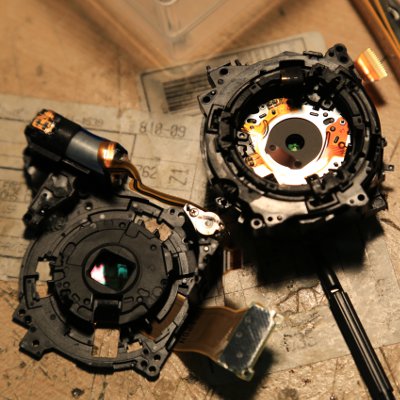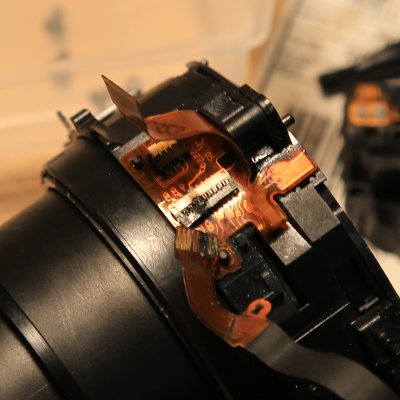Canon PowerShot S110 repair attempt

This camera took a brief dip in Erawan Falls during a particularly clumsy moment. Immediately the camera started acting up, and after a day or so of drying out, it would “work” for a few seconds and then shut itself down with a low battery warning. This should have been a tipoff that I should leave it alone for further investigation. However I pressed on with attempts to get it working again, despite the bad omen. After an aggressive attempt or two to get the camera to stay on, swapping batteries in and out hoping maybe to burn out a contaminant causing a short, it came somewhat back to life. Now able to start up normally, it would take photos, but only in low light. Any sunlight would cause white-out frames. Normally it would run for a few minutes and then shut down with a “E32 Camera Error” message. A bit later I realized there was something in the lens assembly that was loose, as the preview image wobbled a lot with motion.
Finally deciding that professional repair from Canon wasn’t going to be an option, and expecting to replace it anyway, I went ahead with disassembly, holding out a waning hope that a simple cleaning and reassmbly would do the trick.
I have a rekindled respect for the souls who spend their days assembling cameras like this one. There is no free space inside, and plenty of tricky overlapping flat-flex cables, with at least a half-dozen different types of screws holding it together. After an hour of careful (though thankfully straightforward) disassembly, I got the lens assembly to pieces and what I found was not what I’d hoped to see. It appears that the killing blow was delivered by the water shorting some lines at a flat-flex connector, and the power available on these lines was persumably enough to burn the connector up. I’m sure my overly aggressive attempts to get the camera to power on when it was clearly consuming far more than nominal power didn’t help with the permanent damage, but I’m also not sure this short would have been rectified without risky disassembly anyway.

Unfortunately not repairable. Maybe with a new flex cable, but would Canon have sold me one? I don’t think so. Even if they would, I wasn’t particularly careful with disassembly, and unlike those Japanese factory workers, I doubt my ability to fit the puzzle back together. Alas, in the end it didn’t matter, as the universe clearly didn’t want me to have this camera in working order—after a frustrating reassembly of the lens mechanism, I tore a different flat-flex trying to get it to seat correctly in its connector. Then I damaged the connector itself trying to figure out where I was going wrong.
RIP PowerShot S110. You served me well for the two months I owned you in working order. I should’ve followed my own advice and let you dry out before pumping you full of LiIon juice.
Now to go camera shopping…